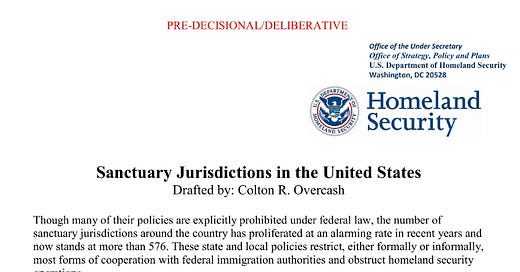Wishing a very happy #FOIAFriday to all who celebrate, and sending a very special expression of gratitude for all of you who support this work with paid and unpaid subscriptions, sharing, and tips. It’s a privilege to be able to learn alongside you.
/ˈsaNGk(t)SHəˌwerē/
From the Latin “sanctus”, “sanctuary” in English primarily refers to a “holy place,” often the innermost part of a holy site, “protected by ecclesiastical immunity” in the Christian tradition. Beyond its religious meaning, dictionaries define a sanctuary as a “place of refuge or safety” or a place of “refuge and protection.” In the context of nature and wildlife, a sanctuary is a “refuge where predators are controlled and hunting is illegal.”
A safe place. A holy place. A place of refuge. Where predators are controlled, and hunting is illegal.
In the 1980s, the sanctuary movement was a collective, transnational refusal to pliantly accept the genocidal imperialist interventions in Central America that forced migrants to seek safety from the consequences of U.S. foreign policy in the U.S. interior. Led by believers of all faiths, sanctuary movements resisted political prosecution and ultimately triggered massive changes in U.S. immigration law that protected from deportation and legalized literally millions of displaced people.
Stephen Miller’s worst nightmare.
Profane Insecurity
Yesterday, the U.S. Department of Homeland Security (DHS) released its ominous-sounding Sanctuary City list. The agency says the list “exposes” jurisdictions “defying federal law.” It doesn’t really say how any of the governments on the list are doing these things. ICE Detainers are requests, so policies refusing to honor them can’t defy anything. State and local data generally belongs to the governments collecting it, so refusing to share that data with the feds can’t defy anything. And since ICE doesn’t pay for or reimburse local cops (most of the time), the Tenth Amendment’s anti-commandeering principle and decades of Republican-led litigation over “states’ rights” means the feds can’t force cops to donate their time to DHS (the nation’s single-largest domestic-funded law enforcement agency—larger than every single other one combined).
The accusation from the current DHS Secretary’s quote is that these jurisdictions “harbor” people and “defy federal law.”
The list actually gets basic things blatantly wrong about some of the entities on the list — like the fact that Nashville and Davidson County are a municipal government, meaning you can’t really put Nashville on the list and leave Davidson County off, no matter how much you might try to share your favorite 287(g)-pushing, Secure Communities-evangelizing Sheriff. ICE does this anyway, of course, because the very government it would like to put on the list (the Metropolitan Government of Nashville and Davidson County) has a contract with ICE to hold migrants for up to 72 hours after they transfer into federal custody.
During the first reign of the Trump regime, hundreds of jurisdictions adopted sanctuary policies, exercising their constitutional and democratic rights to enforce the limits of what the federal government gets to do. The administration tried and failed to punish some jurisdictions for passing laws and enacting policies that consecrated their holiness of their communities by creating safety and refuge, controlling predators, and making hunting illegal.
16 of those jurisdictions have already obtained a preliminary injunction against this term’s cast of characters withholding funding based on their democratically enacted policies.
According to some back-of-the-envelope, unvetted research by ChatGPT’s DeepResearch tool, the DHS list covers jurisdictions representing around 119 million people, based on 2023 Census evidence, and $7.2 Trillion of U.S. economic output, AI says.
It’s more than 1/3 of the U.S. population and around a quarter of the U.S.’s $27 trillion GDP. These places are headquarters to 213 Fortune 500 companies. It’s like 42 million more votes than Trump received in the 2024 election (77M).
These 500+ jurisdictions (some of whom vigorously protest their status as a “sanctuary”) made a choice about how much they wanted to be involved in the deportation business. It’s now one the federal government seeks to punish.
Based on the most recent data, the combined market capitalization of the 213 Fortune 500 companies headquartered in the jurisdictions listed on the Department of Homeland Security's Sanctuary Jurisdictions list is approximately $30.5 trillion as of 2024. This figure represents about 71% of the total market value of all Fortune 500 companies, which collectively amount to $43 trillion.
FOIA Docs Provide Sanctuary Analysis
This incredibly detailed and remarkably unredacted 146-page FOIA record obtained by a colleague a few years ago through litigation involving a completely different issue sheds light on the question. It may also prove useful to officials in designated jurisdictions, because it lays out DHS’s rationale for designated more than 576 states, counties, and cities “sanctuary jurisdictions.”
There’s something really remarkable about this document, and the one below: They were done by a DHS staffer who’s been a longtime anti-immigrant, right-wing operative and previously worked on the staffs of folks who said all sorts of horrible things about immigrants. But he did this work in 2021. Guess who was President and in charge of DHS in 2021.
This shorter, 24-page document offers a top-line overview of state laws and litigation ICE claims will impact its enforcement activities.
There’s Washington:
And Oregon:
New Jersey:
And Colorado:
‘This is a Government; This is Not An Orphanage’
If you’re wondering what it looks like when roving bands of deportation police snatch people they’re racially profiling from the streets, throw them into caged busses and vans, beat them with rifles, and deport people born in the country because the government stripped them of birthright citizenship—all things that sit ominously on the horizon, I cannot recommend highly enough the newest Al Jazeera Fault/Lines documentary piece on deportations from the Dominican Republic to Haiti, Nowhere to Belong.
“You sound as if you were a human rights organization more than a journalist.”
- Roberto Álvarez, Foreign Affairs Minister of the Dominican Republic (Graduate of John Hopkins & Georgetown)
What we see and hear in this piece is not some far-off, dystopian future. It’s what’s happening now, and what those in power want to happen in the future, just with far less capital and even less shame. The interview with the Dominican Foreign Ministry (which he abruptly ends after accusing the reporter of sounding more like a human rights organization than a journalist) could have been any number of American politicians — including those throughout the previous administration.
This is what it looks like on film where there’s no sanctuary. Seem nice? No? Good. Time to organize!
Organizing to Protect the Idea of Protection
NDLON has dubbed the DHS list the “sanctuary all stars” list, and accurately described it as “utter nonsense.”
The Immigrant Legal Resource Center has shared a number of resources for those seeking to protect sanctuary, and fight back against this nonsense.
What does it mean for a jurisdiction to be on this list?
DHS in its announcement stated, “each jurisdiction listed will receive formal notification of its non-compliance with Federal statutes.” As of now, we do not know what the “formal notification” will entail. However, we do know that even before the list was promulgated, the administration already sued Cook County / Illinois, Denver / Colorado, Rochester NY, and others. We will be tracking this closely and will provide updates on how the Attorney General and DHS will implement the notification process.
Regardless of DHS’s list and what the Attorney General (DOJ) comes up with in their list, we know that this is a battle the government has lost in the past and continues to lose. Just recently, on April 24th, a federal court blocked Trump’s administration from withholding federal funding from a dozen sanctuary jurisdictions. Additionally, on May 9th, the federal court issued an order enforcing his block and clarified that the administration cannot circumvent his block by issuing new executive orders.
. . .
1. Federal court order, granting preliminary injunction against the Trump administration (April 24, 2025)
2. Federal court order enforcing preliminary injunction (May 9, 2025)
3. ILRC Resisting Authoritarianism: Our Collective Struggle Against Trump’s Escalating Attacks on Immigrant Communities (April 2025)
4. ILRC Fact Sheet on Sanctuary Policies and 8 USC 1373 (March 8, 2025)
5. ILRC Immigration Enforcement Takeover at the Department of Justice (February 12, 2025)
6. ACLU Letter and Memo on the Trump Administration’s Legally Baseless Threats Against State and Local Officials (January 23, 2025)
7. Joint Statement from Thirteen State Attorneys General: State and Local Law Enforcement Cannot Be Commandeered for Federal Immigration Enforcement (January 23, 2025)
8. Just Security online forum at NYU School of Law What Just Happened: Sanctuary Policies and the DOJ Memo’s Empty Threat of Criminal Liability (January 23, 2025)
9. National Immigration Project: Setting the Record Straight About Sanctuary Policies (January 22, 2025)
10. American Immigration Council Sanctuary Policies: An Overview (February 2025)
11. ILRC, IDP, and Fair Defense Project The Promise of Sanctuary Cities and the Need for Criminal Justice Reforms in an Era of Mass Deportation (May 4, 2017)
13. ILRC Update on the Lawsuits Against Executive Order Defunding Sanctuary Cities (October 2021)
14. ILRC Growing the Resistance How Sanctuary Laws and Policies Have Flourished During the Trump Administration (December 2019)
Sanctuary policies are the results of demands made and won by organized communities who envision a better world. They are under attack because they are effective. Local politics is uniquely susceptible to public pressure. So, if you’re reading this and your jurisdiction is on the list, maybe say “Thank You” and tell them you expect them to stay there and not cave to this bush league intimidation.









